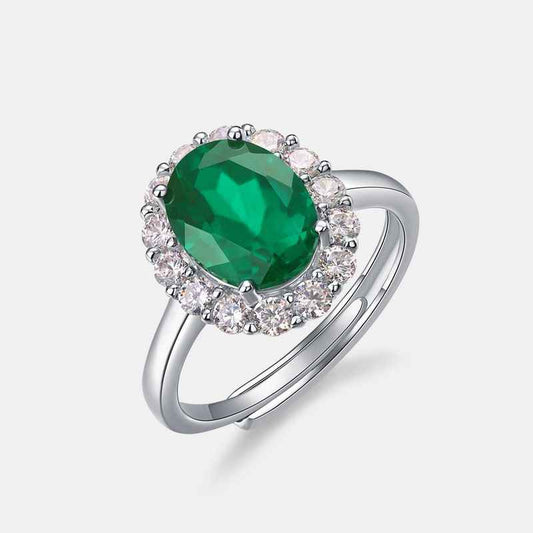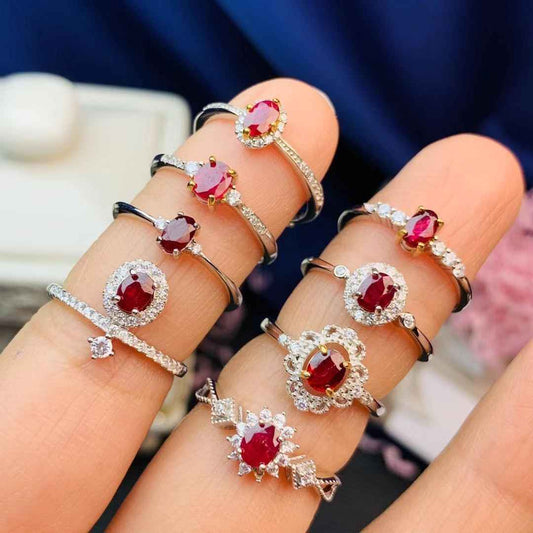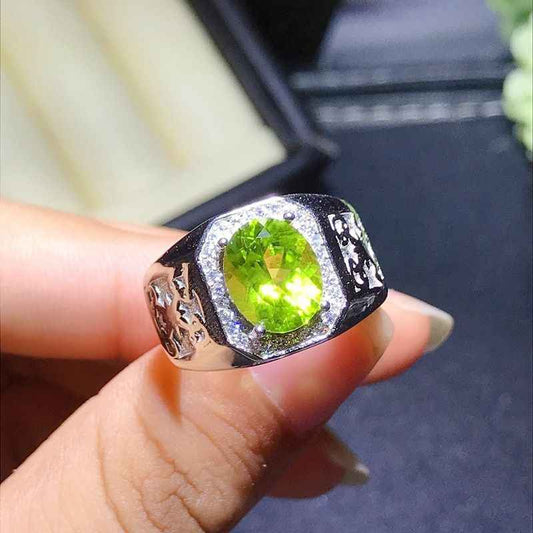Unveiling the Magic of Amethyst Jewelry: Beauty, History, and Spiritual Power
Share

Amethyst, with its captivating purple hues and rich history, is one of the most beloved and sought-after gemstones in the world. Known for its spiritual and healing properties, amethyst has been treasured for centuries by royalty, spiritual leaders, and gemstone enthusiasts alike. In this detailed guide, we will explore the fascinating world of amethyst jewelry, covering its history, significance, varieties, and how to choose and care for your amethyst pieces. Whether you're drawn to amethyst for its beauty, its metaphysical properties, or its significance as a birthstone, this blog will provide everything you need to know about this enchanting gemstone.
What is Amethyst?
A: Amethyst is a variety of quartz that is prized for its stunning purple color, which can range from pale lilac to deep violet. The color of amethyst is primarily due to the presence of iron and other trace minerals within the crystal. It is a relatively hard gemstone, with a rating of 7 on the Mohs scale, making it durable enough for everyday wear in jewelry.
Amethyst's name is derived from the ancient Greek word "amethystos," which means "not intoxicated." This is a reference to the belief that amethyst could protect its wearer from drunkenness and overindulgence. The gemstone has been associated with various myths and legends throughout history and has been a symbol of power, spirituality, and protection.
The History and Symbolism of Amethyst
A: Amethyst has a rich and storied history that spans multiple cultures and civilizations. The ancient Egyptians used amethyst in their jewelry and carvings, believing it to be a protective stone. In ancient Greece and Rome, amethyst was associated with the god of wine, Bacchus (Dionysus), and was worn to prevent drunkenness and promote clarity of mind.
During the Middle Ages, amethyst was considered a symbol of royalty and was used in the regalia of kings and queens. It was also a favored stone among the clergy, who wore it as a symbol of piety and spiritual wisdom. The deep purple color of amethyst has long been associated with nobility, power, and spiritual enlightenment.
In modern times, amethyst continues to be cherished for its beauty and symbolism. It is the birthstone for February and is often given as a gift to celebrate the sixth wedding anniversary. Amethyst is also associated with the zodiac sign Pisces, making it a popular choice for those born under this sign.
Varieties of Amethyst
A: While amethyst is most commonly known for its purple color, there are several different varieties and shades of amethyst, each with its own unique appeal:
-
Deep Purple Amethyst: This variety is the most highly prized and is often referred to as "Siberian" amethyst. It has a rich, deep purple color with flashes of red or blue and is typically found in Brazil and Uruguay.
-
Lavender Amethyst: Lavender amethyst is a lighter, softer shade of purple. It is less intense than deep purple amethyst but is still highly valued for its delicate beauty and soothing energy.
-
Green Amethyst (Prasiolite): Prasiolite is a rare green variety of amethyst that is created when purple amethyst is heated naturally or artificially. It has a pale green color and is often used in unique and modern jewelry designs.
-
Ametrine: Ametrine is a naturally occurring combination of amethyst and citrine in a single stone. It displays both purple and yellow hues, creating a striking contrast. Ametrine is primarily found in Bolivia and is valued for its rarity and beauty.
-
Chevron Amethyst: Chevron amethyst is characterized by its unique banded patterns of white quartz and purple amethyst. These bands create a "V" or chevron pattern, making it a popular choice for decorative and healing purposes.
-
Cape Amethyst: Cape amethyst is a blend of amethyst and milky quartz, resulting in a stone with a soft, cloudy appearance. It is often used in beads and cabochons for jewelry.
The Metaphysical Properties of Amethyst
A: Amethyst is widely regarded as one of the most powerful and versatile healing stones in the world. It is associated with the third eye and crown chakras, which are linked to intuition, spiritual awareness, and higher consciousness. Here are some of the key metaphysical properties of amethyst:
-
Spiritual Growth: Amethyst is known as a stone of spiritual growth and enlightenment. It is believed to enhance intuition, psychic abilities, and spiritual awareness, making it a popular choice for meditation and spiritual practices.
-
Protection: Amethyst is a protective stone that is said to guard against negative energies, psychic attacks, and harmful influences. It is often used as a talisman to protect the wearer and to create a shield of spiritual light.
-
Emotional Healing: Amethyst is known for its calming and soothing energy, making it an excellent stone for emotional healing. It is believed to help release stress, anxiety, and negative emotions, promoting inner peace and tranquility.
-
Clarity and Focus: Amethyst is associated with mental clarity and focus. It is believed to enhance cognitive function, improve decision-making, and support clear thinking, making it a valuable stone for students, professionals, and anyone seeking mental clarity.
-
Detoxification: Amethyst is believed to have detoxifying properties that can help purify the body and mind. It is often used in crystal healing to support the release of toxins and to promote overall well-being.
Amethyst in Jewelry
A: Amethyst's stunning color and versatility make it a popular choice for all types of jewelry. Whether set in rings, necklaces, bracelets, or earrings, amethyst adds a touch of elegance and sophistication to any piece. Here are some popular ways amethyst is used in jewelry:
-
Amethyst Rings: Amethyst rings are a classic choice for both men and women. The deep purple color of amethyst makes it an ideal stone for statement rings, engagement rings, and everyday wear. Amethyst rings are often set in sterling silver, white gold, or platinum to enhance the stone's vibrant color.
-
Amethyst Necklaces: Amethyst necklaces, particularly those featuring a single amethyst pendant, are a popular choice for those who want to keep the stone's energy close to the heart. Amethyst necklaces can range from simple, understated designs to elaborate, multi-stone pieces.
-
Amethyst Bracelets: Amethyst bracelets are often designed with multiple amethyst stones, either as a string of beads or set in a metal band. These bracelets are not only beautiful but also provide continuous energy and protection throughout the day.
-
Amethyst Earrings: Amethyst earrings, whether in stud, drop, or hoop designs, add a touch of elegance and color to any outfit. The deep purple color of amethyst complements all skin tones and is especially striking in evening wear.
-
Amethyst Brooches and Pins: Amethyst brooches and pins were particularly popular in the Victorian era and are still cherished by collectors today. These pieces often feature intricate designs and are highly valued for their craftsmanship.
How to Choose Amethyst Jewelry
A: When choosing amethyst jewelry, there are several factors to consider to ensure you select the best piece for your needs and preferences:
-
Color: The color of amethyst is one of the most important factors in determining its value. Deep, rich purple amethyst with flashes of red or blue is the most highly prized. However, lighter shades of amethyst, such as lavender or pale lilac, are also beautiful and may be more affordable.
-
Clarity: High-quality amethyst should be eye-clean, meaning it is free of visible inclusions or flaws. The stone should have a consistent color and good transparency, allowing light to pass through and enhance its brilliance.
-
Cut: The cut of the amethyst is crucial in showcasing its color and brilliance. Well-cut amethyst gemstones will reflect light beautifully and have a symmetrical, balanced appearance. Popular cuts for amethyst include round, oval, cushion, and emerald.
-
Setting: The setting of the amethyst can greatly impact the overall look and feel of the jewelry. Amethyst pairs well with both white and yellow metals, such as sterling silver, white gold, yellow gold, and platinum. The choice of setting will depend on your personal style and how you plan to wear the jewelry.
-
Size: Amethyst is available in a wide range of sizes, from small accent stones to large, statement pieces. The size of the amethyst will affect both the price and the impact of the jewelry. Consider how you plan to wear the piece and choose a size that suits your style and budget.
Caring for Your Amethyst Jewelry
A: Proper care is essential to maintaining the beauty and longevity of your amethyst jewelry. Here are some tips on how to care for your amethyst pieces:
-
Cleaning: Clean your amethyst jewelry regularly using warm soapy water and a soft brush. Avoid using harsh chemicals or ultrasonic cleaners, as these can damage the stone. Rinse the jewelry thoroughly and dry it with a soft cloth.
-
Storage: Store your amethyst jewelry in a soft pouch or separate compartment to prevent scratches and damage. Keep it away from direct sunlight for extended periods, as prolonged exposure to sunlight can cause the color of the amethyst to fade.
-
Wearing: Amethyst is a durable stone, but it's still advisable to remove your jewelry when engaging in activities that could scratch or chip the stone, such as gardening or exercising. Be mindful of contact with chemicals, such as perfumes and lotions, which can damage the stone or setting.
-
Recharging: Amethyst can be recharged by placing it in moonlight or on a quartz crystal cluster. Avoid placing amethyst in direct sunlight for recharging, as this can cause the color to fade.
Amethyst as a Birthstone
A: Amethyst is the birthstone for February and is often given as a gift to those born in this month. As a birthstone, amethyst is believed to bring protection, peace, and spiritual awareness to the wearer. It is also associated with the zodiac sign Pisces, making it a meaningful and personalized gift for those born under this sign.
Symbolism of Amethyst in Relationships
A: Amethyst is often associated with love, friendship, and emotional balance, making it a popular choice for relationship jewelry. The stone's calming energy is believed to promote understanding, trust, and harmony in relationships. Amethyst is also said to enhance communication and help resolve conflicts, making it an ideal stone for couples.
Amethyst jewelry, such as rings, necklaces, and bracelets, can be given as a symbol of deep emotional connection and commitment. Whether as a romantic gesture or a token of friendship, amethyst jewelry carries a powerful message of love and loyalty.
Amethyst in History and Folklore
A: Amethyst has been revered throughout history for its mystical and protective properties. In ancient Egypt, amethyst was carved into amulets and worn as protection against harm. In ancient Greece, amethyst was believed to prevent intoxication, and cups made from amethyst were used to ward off drunkenness.
During the Middle Ages, amethyst was worn by bishops and other clergy as a symbol of piety and spiritual wisdom. It was also believed to protect against evil spirits and witchcraft. In more recent history, amethyst has been associated with the suffragette movement, as its purple color represented the fight for women's rights.
Amethyst has also been used in various religious and spiritual practices. It is often used in meditation to enhance spiritual awareness and connect with higher realms. Amethyst is also believed to have the power to purify the mind and body, making it a valuable tool for healing and transformation.
The Rarity and Value of Amethyst
A: While amethyst is relatively abundant compared to other gemstones, high-quality amethyst with deep, rich color can be rare and valuable. The value of amethyst is determined by factors such as color, clarity, cut, and size. Bright, vivid colors with high clarity are the most sought-after and valuable.
Large, well-cut amethyst stones are particularly prized and can command higher prices. However, amethyst is still more affordable than other precious gemstones, making it an excellent choice for those seeking beauty and value.
Final Thoughts on Amethyst Jewelry
Amethyst is a gemstone that combines beauty, history, and powerful metaphysical properties. Whether you’re drawn to amethyst for its rich purple color, its spiritual significance, or its role as a birthstone, this versatile stone offers something for everyone. Amethyst jewelry is a timeless choice that adds elegance and meaning to any collection.
Whether worn in rings, necklaces, or bracelets, amethyst is a gemstone that will continue to captivate and inspire for generations to come. Its calming energy, spiritual significance, and rich history make it a treasured addition to any jewelry collection. Explore the world of amethyst jewelry and discover the many ways this enchanting stone can enhance your life.





